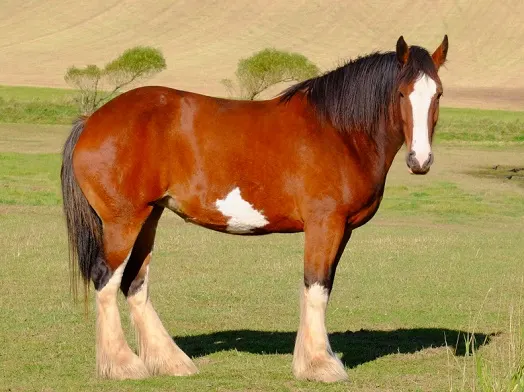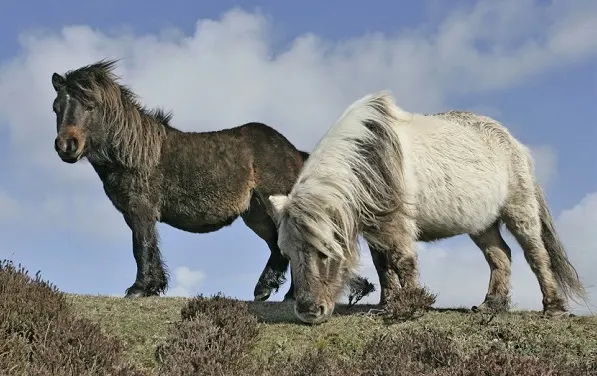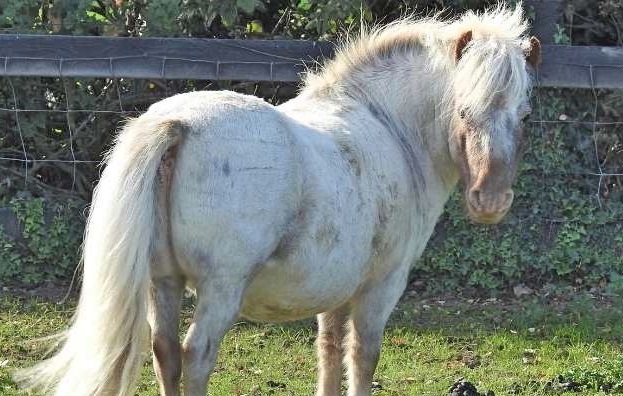
From charming cities to stunning castles and rugged landscapes, Scotland is home to some stunning sites. Scotland is also home to some beautiful horses, both big and small.
For hundreds of years, horses have played an important part of life in Scotland. Horses and ponies have been bred for pulling carts, plowing fields, and working in coal mines.
Five Scottish horse and pony breeds still around today are the Clydesdale, Shetland Pony, Highland Pony, Eriskay Pony, and Garron.
Though many of Scotland’s horse and pony breeds are rare, many avid equestrians are working to preserve these magnificent breeds.
Here are 6 native Scottish horse breeds.
1. Clydesdale

Graham Chamberlain / Shutterstock.com
Perhaps the most recognizable Scottish horse breed is the Clydesdale. They are one of the most popular breeds of draft horses in the world.
The Clydesdale horse originated in Lanarkshire, Scotland, near the River Clyde. The breed first got its start in the 1700s when imported Flemish stallions were bred with local mares. Later on, Shire blood was introduced into the breed, and by 1826, the breed was first exhibited under the name Clydesdale.
Clydesdales typically stand between 16-18 hands tall and weigh between 1,700-2,000 pounds. They are generally bay with white socks, but they can also be roan, black, or sorrel. This exquisite breed is recognizable for having large, muscular builds, arching necks, powerful hindquarters, and feathering on their legs.
Today, Clydesdales are most recognizable for pulling the world-famous Budweiser hitch. They have friendly, easy-going personalities, making them lovely horses for the whole family. They are used for driving and in-hand competitions and become increasingly popular riding mounts.
Also read: 7 Fascinating Facts About Clydesdale Horses
2. Shetland Pony

navatu / Shutterstock.com
One of the most adorable pony breeds, the Shetland pony originates from the Shetland Isles in the north of Scotland. These hardy ponies were able to adapt to the islands’ harsh climate.
Though the true origin of the Shetland pony has faded with time, small ponies have called the rugged Shetland Islands home for at least 4,000 years. The Celtic pony likely figured into the breed and other ponies brought over by Norse people.
Thanks to their strength, resilience, and hardiness, Shetland ponies were once pit ponies in coal mines during the Industrial Revolution. They were also popular choices for pulling carts and even plowing farmland. Shetland ponies are popular riding mounts for small children and even make wonderful driving ponies.
Shetland ponies have a compact body with short legs, a thick neck, and a full mane and tail. They come in almost every coat color including solid and pinto patterns.
American Shetland ponies tend to be more refined, taller, and sleeker than their Scottish counterpart. Shetland ponies weigh around 400-450 pounds and are no taller than 10.5 hands in the United Kingdom and 11.5 hands in America.
Also read: 10 Interesting Facts About Shetland Ponies
3. Highland Pony

The hardy Highland pony is native to the Scottish Highlands and Islands. They are one of the largest mountain and moorland pony breeds of the British Isles.
Over hundreds of years, the Highland pony has adapted to the harsh climate of the Scottish Highlands. They have been used to plow fields, pull carriages, and even carry men of the clans into battles throughout history.
Today, these lovable ponies are popular for jumping, dressage, hunter pleasure, and driving thanks to their docile temperaments.
In the 1800s, Queen Victoria took a fancy to the Highland ponies, and they became a long tradition among the Royal family. Today, Queen Elizabeth is a patron of the Highland Pony Society and a longtime owner and exhibitor of the breed.
Highland ponies have a compact body, well-carried head and neck, and powerful hindquarters. They come in several different shades of dun including mouse, yellow, grey, and cream, as well as grey, brown, black, and bay. Highland ponies stand between 13- 14.2 hands tall and weigh between 900-1,100 pounds.
Also read: 9 Facts About Queen Elizabeth and Horses
4. Eriskay Pony

Erni / Shutterstock.com
The Eriskay pony originated from the Isle of Eriskay in the Outer Hebrides of western Scotland. They are among the last surviving descendants of the original native ponies of the Western Isles.
The origins of the Eriskay breed are ancient, tracing back to roots in Celtic and Norse breeding. They were used as crofters ponies until the middle of the 19th century, often bringing home peat and seaweed in baskets. In addition, they would also pull carts and even take the children to school.
Eriskay ponies were once abundant in numbers. However, a desire for larger ponies led their numbers to dwindle.
Norwegian Fjords, Arabian, Clydesdales, and other stock were brought in to create larger ponies for draught work. This left only a small number of purebred Eriskay ponies and even today the breed is critically endangered by the Rare Breed Survival Trust.
Eriskay ponies have deep chests, fine legs, and muscular necks, with friendly dispositions and easy-going temperaments. They make reliable riding mounts for children in a variety of disciplines and they excel in combined driving. Eriksay ponies stand between 11.3- 13 hands tall and weigh between 700-900 pounds.
Also read: 10 Native English & British Horse Breeds
5. Garron

The Garron comes from the Highland pony and originates from the mainland of Scotland. They are bred from crossing Highland ponies with Clydesdales, creating a larger, heavier version of the Highland pony.
Garrons were first bred for farming, particularly for their hardiness and ability to work slopes. These reliable horses have been mentioned numerous times in literature, including in George R. R. Martin’s fantasy series A Song of Ice and Fire.
Garron ponies stand between 13.2 to 14.2 hands, weighing around 900-1,200 pounds. They have a sturdy, compact build similar to the Highland and come in a variety of colors.
Also read: 10 Facts About the Horses from Game of Thrones
6. Galloway Pony

Malcolm Carruthers / The famous “Galloway” Pony / CC BY-SA 2.0
Though now extinct, the Galloway Pony hailed from Scotland and Northern England. These hardy, robust ponies were once used for border raids and also for herding livestock.
The Galloway breed was noted for its “good looks, a wide, deep chest, and a tendency to pace rather than trot.” These durable ponies were able to navigate the Scottish countryside’s difficult terrain and harsh weather, making them ideal for draught work. Though they were hardy, they had a small head and neck with an elegant build.
Galloway ponies were generally bay or black, standing between 12-14 hands tall. Crossbreeding of Galloway ponies was popular, and they influenced many breeds, including the Newfoundland pony, Highland Pony, and Fell pony.
Eventually, the breed began to be absorbed into the Fell Pony, causing purebred Galloways to slowly fade away.